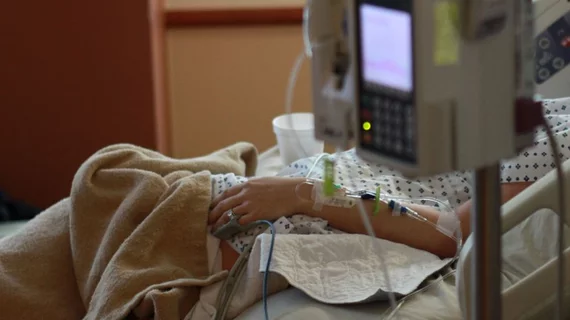New research details how a deep convolutional neural network (dCNN) uses a scoring system to predict prognosis for COVID inpatients at a nearly expert level based off CT scans.
The dCNN forecasted hospital stay, intensive care unit admission and intubation with an interobserver agreement of 0.892 when scoring chest CT images from hospitalized patients with COVID pneumonia. Experts involved in the study suggest that the dCNN could assist clinicians who treat COVID patients with assessing disease severity and other prognostic factors that might direct treatment plans.
“The use of artificial intelligence deep learning models to prognosticate from CT images has been identified from the beginning of the pandemic as a potential way to expedite the triage process, improve prognostication, and guideline utilization of resources” corresponding author U. Joseph Schoepf, MD, from the Division of Cardiovascular Imaging at the Medical University of South Carolina in Charleston, and co-authors explained. “Utilizing AI severity scoring may be helpful in meeting the challenge of practical, reproducible triage of COVID-19 patients by identifying patients at high risk for morbidity and mortality.”
The authors noted that severity scoring systems help to strengthen clinical decision-making processes by providing high quality, evidence-based protocols using image features from specific pathologies. However, manual segment severity scoring is both challenging and time consuming. Using artificial intelligence to streamline similar diagnostic processes during patient triage has proved beneficial since the beginning of the pandemic, but few studies have specifically analyzed AI’s efficacy for scoring disease severity based on chest CT images of COVID patients. And many that have examined its effectiveness have been based on public datasets, not real-world cohorts.
This is what led researchers from the Medical University of South Carolina to test a previously trained dCNN on real world patients. Their cohort included individuals who received chest CTs after presenting to the emergency room, 98 of whom were diagnosed with COVID and 168 who were not. Airspace opacity was evaluated across the entirety of patients’ lungs, which defined the severity scores that were used to predict COVID diagnosis and inpatient outcomes.
Interobserver agreement for airspace opacity scoring was 0.892. Using the opacity scoring system, experts developed probability outcomes. Patients with a score of 13/25 had a 25% chance of being admitted to the ICU, while those with a 17/25 had a 25% chance of intubation. Mortality likelihood was 25% with scores of 20/25. The experts found that the larger a patient’s opacity score was, the more likely they were to be admitted to the ICU and face intubation.
“The AI algorithm was highly accurate compared to attending radiologists with ICCs approaching human-level agreement,” the authors stated. “The AI algorithm adequately quantifies burden of disease in COVID-19 patients and can provide a service which would otherwise be too time consuming for radiologists and clinicians.”
The detailed study can be viewed in Academic Radiology.
More on COVID-19 in radiology:
PET scans spot brain abnormalities in long COVID patients
Intrathoracic complications in COVID patients: Incidence, associations and outcomes
Imaging suggests blood clots are more common in COVID than pneumonia
These ultrasound features distinguish between COVID vaccine-related and malignant adenopathy

